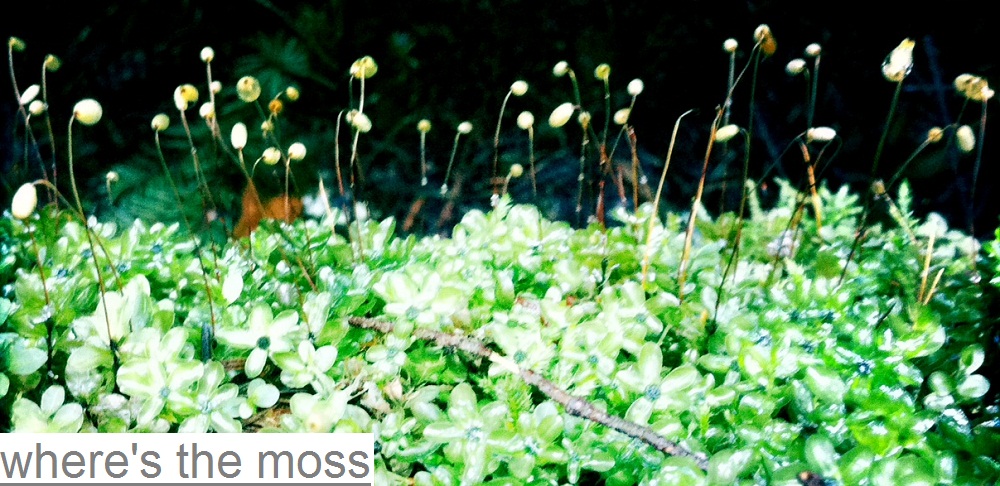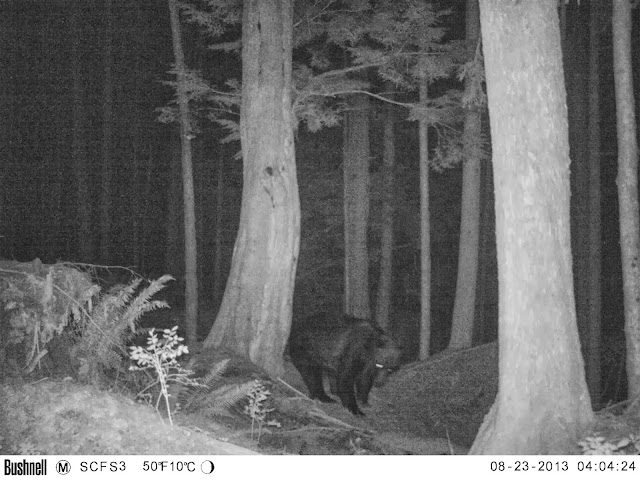Ahta is the queen of streams. The water here is clean and cold, the river basin wide and covered in smooth cobble-stones. As streamwalkers, Lauren and I swing our legs and trip over moss and fallen old-growth to climb along the banks, balancing on huge fallen trees-as-bridges to criss-cross our way upstream. We gaze down into pools of hundreds of fish, sometimes eight or nine deep, multiplying and calculating the population, seeing numbers in the thousands.

Located at the mouth of Bond Sound on the mainland coast, Ahta is thought of as the southernmost extent of the Great Bear Rainforest. Indeed, Great Bears are found here; each time we visit to salmoncount, we share this river space with grizzlies. They walk by us on the streamside, ears attuned to the splashing fish, lifting onto back legs and rubbing against trees. We've seen them in the river eating salmon, peeling the skin off the bones, or swimming through pools, arcs of fish avoiding their huge claws. Their footprints are everywhere, deep, earthy holes in the forest floor. As we move upstream, through thick matted moss and decaying Douglas fir, we follow the bear highways created by these creatures putting their feet into exact footprints of the bear before it, pressing scent into the pathway, reinforcing their belonging to this place, and Ahta's belonging to them.
The salmon here have been pairing up, digging redds in the cobble, pushing stones aside and hoping their eggs will stay safe while they incubate for the winter months. The spring will see tiny pink and chum fry emerge and sweep and tumble out into the sedgy estuary. Water ouzels, small songbirds who run on the river bottoms, hide away salmon eggs, and feast on the pink-jewels after shaking the fresh cool water out of their grey-black feathers. Juvenile eagles beat their ruffled wings over our heads, and we follow wolf prints along portions of the sandy banks.
This is where the salmon-forest came alive for me. I have read that the rich ocean-derived nutrients brought back by these fish to their natal streams would carry into the surrounding forest and feed the entire community. Here, at Ahta's banks, this picture is carnally painted; the sharp smell of decaying chum, pink, and coho carries far into the surrounding forest and grizzly, blackbear, ouzel, wolf, heron, eagle, gull, merganser, harbourseal, and kingfisher, to name a few, are making their seasonal homes here to feast. This place is thick with salmon carcass, flung everywhere, disintegrating bodies in the loam. The trees, the cedar and hemlock and Douglas fir, the salmonberry shrubs, huckleberry, azelea, salal, are drinking up these nutrients. Linnea borealis, Polypodium glycyrrhiza, Cornus canadensis. The thick moss is dotted by hedgehog mushrooms, yellowfeet, chanterelles, Zeller's Bolete, and angelwings clinging like shingles to rotting logs.
As we turn to go downstream again from the misting waterfalls, the air hangs with whispers of fish ghosts Their gill filaments gasping, their tails ragged, bellies hollow, eggs expelled, and scales rubbed off, protein foam tumbling back down the creek.

Located at the mouth of Bond Sound on the mainland coast, Ahta is thought of as the southernmost extent of the Great Bear Rainforest. Indeed, Great Bears are found here; each time we visit to salmoncount, we share this river space with grizzlies. They walk by us on the streamside, ears attuned to the splashing fish, lifting onto back legs and rubbing against trees. We've seen them in the river eating salmon, peeling the skin off the bones, or swimming through pools, arcs of fish avoiding their huge claws. Their footprints are everywhere, deep, earthy holes in the forest floor. As we move upstream, through thick matted moss and decaying Douglas fir, we follow the bear highways created by these creatures putting their feet into exact footprints of the bear before it, pressing scent into the pathway, reinforcing their belonging to this place, and Ahta's belonging to them.
The salmon here have been pairing up, digging redds in the cobble, pushing stones aside and hoping their eggs will stay safe while they incubate for the winter months. The spring will see tiny pink and chum fry emerge and sweep and tumble out into the sedgy estuary. Water ouzels, small songbirds who run on the river bottoms, hide away salmon eggs, and feast on the pink-jewels after shaking the fresh cool water out of their grey-black feathers. Juvenile eagles beat their ruffled wings over our heads, and we follow wolf prints along portions of the sandy banks.
This is where the salmon-forest came alive for me. I have read that the rich ocean-derived nutrients brought back by these fish to their natal streams would carry into the surrounding forest and feed the entire community. Here, at Ahta's banks, this picture is carnally painted; the sharp smell of decaying chum, pink, and coho carries far into the surrounding forest and grizzly, blackbear, ouzel, wolf, heron, eagle, gull, merganser, harbourseal, and kingfisher, to name a few, are making their seasonal homes here to feast. This place is thick with salmon carcass, flung everywhere, disintegrating bodies in the loam. The trees, the cedar and hemlock and Douglas fir, the salmonberry shrubs, huckleberry, azelea, salal, are drinking up these nutrients. Linnea borealis, Polypodium glycyrrhiza, Cornus canadensis. The thick moss is dotted by hedgehog mushrooms, yellowfeet, chanterelles, Zeller's Bolete, and angelwings clinging like shingles to rotting logs.
As we turn to go downstream again from the misting waterfalls, the air hangs with whispers of fish ghosts Their gill filaments gasping, their tails ragged, bellies hollow, eggs expelled, and scales rubbed off, protein foam tumbling back down the creek.
































.JPG)

